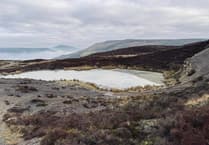The newly established wildflower meadow on Upper Gilwern Common, provided the site for naturalist Andrew Baker to lead year 4 children from Gilwern Primary School in an investigation of the wildlife now found there.
The children, who are taught natural history by class teacher Jaye Phillips, are aware of how crucial pollinators are to the growth of foods like runner beans and tomatoes, as well as to the diets of birds like Robins.
They demonstrated a good understanding and interest of wildlife and had great fun locating Meadow Brown butterflies, Bumblebees, and a ladybird.
The students are looking forward to returning to the meadow next term to continue with their studies.
A blue and black feather, later identified as being from a Jay, was also spotted by a keen-eyed learner.
Last year, Upper Gilwern Common, previously regularly mown, was surveyed by a Botanist from the Monmouthshire Meadows Group. It was found to have a wide range of wildflowers and grasses, signifying a site of local conservation importance.
As a result, this community led initiative, supported and managed by Monmouthshire County Council, as part of their “Nature isn’t Neat” scheme, now ensures that the grass is left uncut from the end of March until August.
We have lost 97 per cent of the type of habitat Upper Gilwern Common provides.
In turn we have lost significant numbers of insects and birds. Thankfully, over time, it is anticipated that this little meadow will become even more diverse, allowing more wildflowers and a wider variety of insects to thrive.
By simply leaving this space alone for part of the year, Gilwern can do a tiny bit to help restore a small piece of our natural environment. At the same time people can enjoy the flowers and insects by following the mown paths that meander around and through the meadow. In addition, wider areas have also been mown to enable picnicking or socialising.





Comments
This article has no comments yet. Be the first to leave a comment.